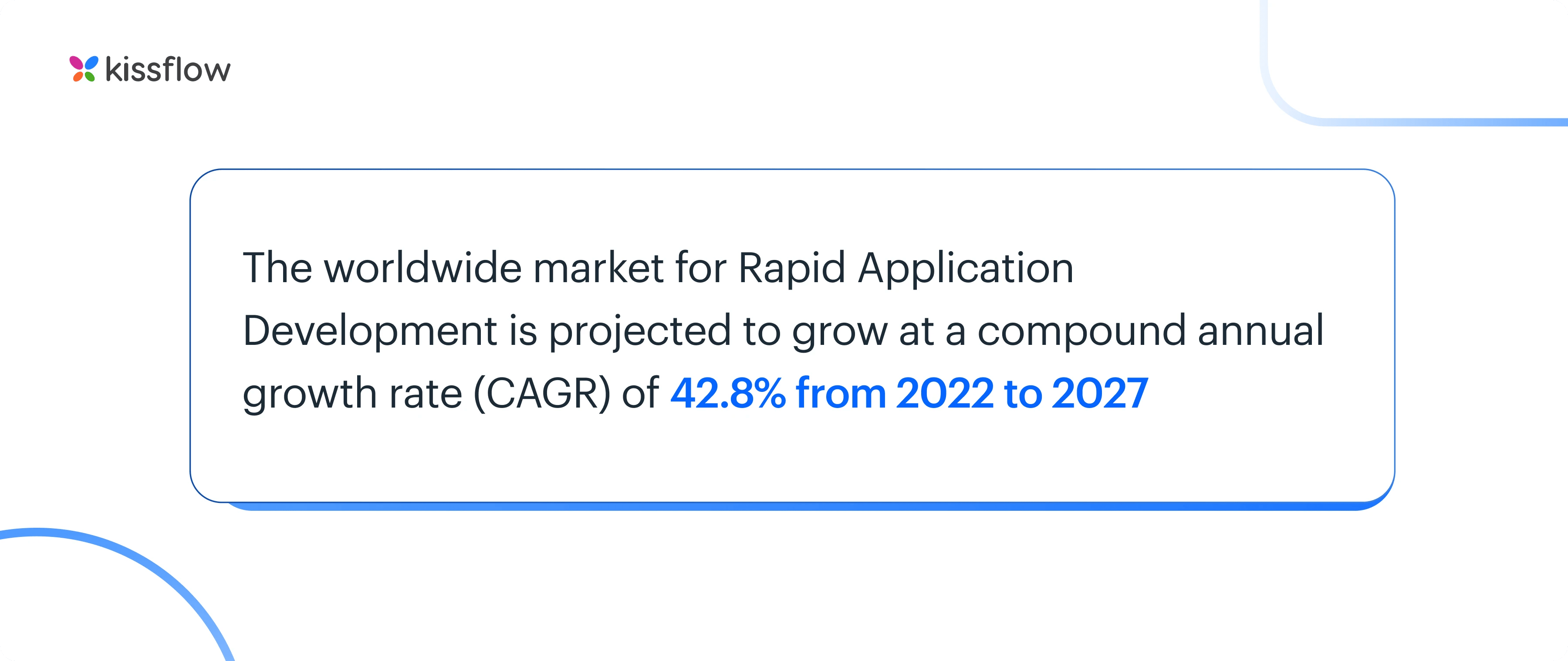
- >
- Application Development >
- What are the Characteristics of Rapid Application Development
What are the Characteristics of Rapid Application Development
Traditional software development has long been the standard method, valued for its meticulous steps designed to ensure software reliability. However, this approach can be time-consuming and resource-intensive. Cutting corners in this process can lead to buggy software or even a non-functional product.
In response to these challenges, Rapid Application Development (RAD) emerged, challenging the status quo of software development. RAD offered the promise of quickly developing applications without compromising on quality, a concept that resonates deeply with CIOs and BTPs navigating the demands of the digital age.
However, as organizations consider adopting RAD, they often grapple with key questions: Does RAD's speed make traditional software development methodologies obsolete? Can every software project be effectively managed using RAD methodologies? The clear answer to both questions is no.
While RAD is a powerful tool in the toolkit of CIOs and BTPs, it is not a universal solution, nor does it replace traditional software development. It serves as an alternative for speeding up certain types of projects while recognizing that traditional methods still hold value in the intricate world of software engineering. The secret lies in determining which approach best aligns with the unique requirements and complexities of each software project.
Every RAD Approach Follows This Structure
To make sense of why the RAD approach isn’t a complete solution, you’ll need to understand what makes up a RAD tools development process, its characteristics, and how it varies from traditional models.
RAD phases follow a cycle of rapid prototyping and quick feedback from the end user to ensure that development is quick and that users are constantly updated on the progress of the software.
The basic characteristics of a rapid application development (RAD) process are:
- Define requirement
- Rapid prototyping
- Receive user feedback
- Finalize product
Define Requirements
Here, the ‘basic requirements’ document is drafted, providing a glimpse of what the final product needs to be. Although you could compare this step to requirement planning in traditional models, RAD implementation isn’t as detailed. The document is only required to provide basic insight, not a detailed vision of what the final product should be.
Once the requirements are planned out, the development team can work on the first prototype.
Rapid Prototyping
In prototyping, basic functions and features of the software are developed with very basic user interfaces. There’s little or no thought given to polish or design aesthetics here. The main point is to give the user the required functions and features. Basic testing is done to ensure there are no bugs in the code. After testing, the prototype is sent to the end user for feedback.
Receive User Feedback
The end user tests the functions in the prototype, seeing if they all work as required. There are often requests to add more features and functionalities at this stage, but this is normal. The feedback stage is a time for developers to get the project in line with the user’s vision. Any and all additional feedback is taken into consideration for the next prototype. These two steps will continue in a loop until every function is implemented.
Finalize Product
Once all the required functions are implemented, the final product is built. Instead of building everything from scratch, all functions and features are taken from previous prototypes. This is more efficient since developers don’t have to code the product again. Since the prototypes and their functions are already tested, developers can be fairly confident the product won’t have as many bugs as it does when building from scratch.
There is a final round of testing to check if all modules work seamlessly with each other. However, the testing done here won’t be as intensive as in a waterfall model.
Once testing is done, the final product is delivered to the end user. This method of rapid prototyping and continuous user feedback can seem like a genius, but it’s not a one-size-fits-all shoe. There are some conditions that need to be met before you can consider using RAD for a project.

Choosing Your App Development Stack: A 11-Point Checklist
Thank you for reaching us!
Thank you for reaching us!
Where RAD Is Usable

The worldwide market for Rapid Application Development is projected to grow at a compound annual growth rate (CAGR) of 42.8% from 2022 to 2027
Rapid development, although useful, is not a fit for every development scenario. For RAD to work, your project needs to meet these conditions.
- Your project must be relatively small. RAD doesn’t work for complicated and drawn-out projects.
- Your development team must also be small. The bigger the team, the more the chance for miscommunication.
- You’ll need to have constant communication and direct access to the users who use the application. Without direct feedback, you lose all the advantages of RAD.
So, with these conditions in mind, where is RAD applicable?
1. When you’ve got to complete a project quickly
RAD enjoys projects with tight deadlines. If you’ve got a project where waterfall models and long development cycles won’t be able to deliver in time, RAD can be a great fit.
2. When you have people who can test your prototypes
Prototypes and iterations are continuously mentioned in RAD, and for a good reason. Prototypes are integral to the development and collecting direct feedback, preferably from end users who understand what you’re trying to do. This isn’t just valuable; it’s indispensable. Without proper feedback, RAD doesn’t have the direction it needs to move a project forward.
3. When you’ve got the budget for RAD
The budget should come as no surprise. In RAD, you’ll have to hire the best developers you can get. Hiring skilled developers means paying them what they’re worth, and that’s never cheap. If you can afford to hire quality people, then you can consider RAD.
When RAD Is Unusable
But RAD isn’t perfect for every scenario. There are some instances where RAD isn’t suitable for software development.
- When you can’t afford to hire highly skilled developers, avoid RAD. Without highly qualified developers, implementing RAD can become more of a problem than a solution.
- When you have a large team, avoid RAD. Large teams complicate communication, eventually becoming a very confusing game of Telephone.
- When you cannot directly communicate with the users who will use the end product, avoid RAD. Without proper communication, RAD does not work.
- When the project is big, avoid RAD. RAD works well with small projects and teams. If a project is too large and complex, RAD breaks down.
If you have a project or team that satisfies any of these conditions, avoid RAD and look elsewhere. But looking at these requirements, it can feel like RAD’s only good for enterprise development, where there are large budgets, skilled developers, in-house requirements where developers can communicate with users, and small and dedicated teams for each project. Does this mean RAD is only useful inside enterprises?
Discover real-world results in our customer success stories.
RAD Is for Companies of All Sizes
Enterprise organizations also have niche software requirements that RAD can efficiently tackle. But that doesn’t mean RAD is exclusively for enterprises. There are other RAD examples where the RAD platform works for smaller organizations.
One example is startups that develop mobile apps. Development teams focusing on mobile apps don’t need to span over dozens of members and involve long and tedious development cycles. With RAD, developers working can develop prototypes quickly. The reduced development time is a boon for startups that only have a limited window before they need to take their product to market to generate revenue.
It can also be used for SMBs where the developed software may not be the main source of revenue. It still impacts how a customer interacts with the product or how employees do their work. RAD models can make an impact on how a team gets their internal work done through automation and process improvements. Here, time is of the essence, and quick development time can make all the difference.
An example of RAD for Purchase Orders
Collecting data for purchase orders and approving them sounds like a very simple process, but readymade options often complicate it. However, you also want to build them on a platform that gives you more than just basic functionality.
To start this RAD example, gather all the people who know the process best, starting with the procurement team. Bring together current forms and a complete understanding of the workflow. Discuss how you want the app to function. With purchase orders, it’s often helpful to also have a vendor database for quick reference to call up information in the form.
Decide what fields should be shown at what steps and if you want to add some conditional steps that only happen when certain parameters are met.
Then, the procurement team can sit alongside someone familiar with Kissflow to build the first prototype. You should be able to have a working form and workflow built within 1-2 hours, depending on the complexity of your form and how many databases you want to link it to.
After getting the basic app up and running, it should be shared with those who are going to be using it. Those requesting purchase orders may have some additional ideas for improving the form or workflow. These changes can be implemented immediately and shown to stakeholders on the spot.
If you are still skeptical about the app development platform you should deploy, check this eBook
How Kissflow Uses RAD
Kissflow's application development platform lets anyone develop their automated process in minutes instead of days or weeks. A single person can use Kissflow to work on developing an application.
This is rapid application development taken to a new level–making applications as quickly as possible and can be used instantly by the entire company.
With visual interface tools to create models quickly and easily, pre-built modules where you don’t have to do the heavy lifting, and drag-and-drop coding to provide a means of customization to those who don’t have the proper coding knowledge, Kissflow is designed keeping in mind that companies want tools that make their lives easier.
The fastest way to create high-value apps
-3.webp)
How much could your organization save with low-code?
Get the impact of a low-code/no-code platform on your application development costs
Related Articles











